Dhiraj Sindhi's Blog
September 3, 2025
'Silk Route' by Sachin Kundalkar Refuses to Stay Still: Queer Longings and Lifetimes in Motion
'Silk Route' by Sachin Kundalkar Refuses to Stay Still: Queer Longings and Lifetimes in Motion Silk Route (Monochrome, #1) by Sachin Kundalkar Book Review by Dhiraj Sindhi
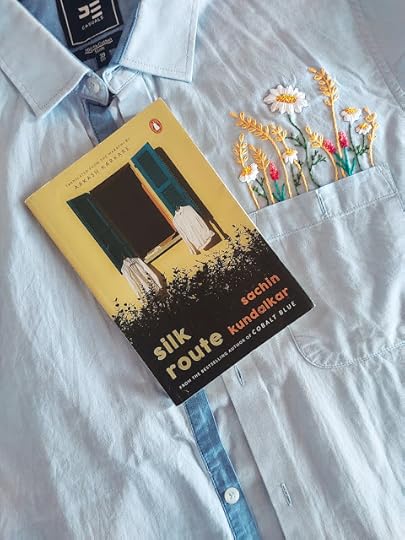 Silk Route (Monochrome, #1) by Sachin Kundalkar
Silk Route (Monochrome, #1) by Sachin Kundalkar Author: Sachin Kundalkar
Translator: Aakash Karkare
ISBN: 978-0143477808
Genre: Queer Literary Fiction
Length: 120 Pages
Publication Date: 25th July 2025Publisher: Penguin Books
Cover Photo: Anuraag Banerjee and Cover Design: Amit Malhotra
Order your copy right now: https://amzn.to/3HP1zQp
About the Author:
Sachin Kundalkar is National Award-winning film maker with twelve Indian feature films to his credit, a screen writer whose work has been adapted into multiple Indian languages including Hindi and Malayalam. He is the author of the celebrated novel ‘Cobalt Blue’ which he wrote in Marathi when he was twenty-three years old. The novel by now has been translated into English, Hindi, Kannada, and Sinhala and has been adapted into a visually stunning feature film.
 Sachin Kundalkar | Photo Credit: KUMAR SS
Sachin Kundalkar | Photo Credit: KUMAR SS
Instagram: @sachincobaltblue
About the Translator:
Aakash Karkare is a writer and translator based in Mumbai. He has worked across film, photography, and journalism, with experience in documentary filmmaking and as a former film critic with Scroll. His debut memoir is forthcoming from Rupa.
 Aakash Karkare | Photo Credit: The Bombay Literary Magazine
Aakash Karkare | Photo Credit: The Bombay Literary Magazine
Instagram: @aakashbagheera
Disclaimer: This review is only intended for initiating discussions. The opinions and views presented in this article are my own and do not reflect anything about the book's author.
When was the last time a book felt like a train you didn’t plan to board, but once you did, you couldn’t step off? Silk Route by Sachin Kundalkar feels exactly like that. An unending chain of stories, each an epilogue that quietly opens into another. You think you’ve reached the last station, and suddenly, you’re already moving again with another story, another train, the journey of which is slowly becoming into a destination. If the author’s name rings a bell, that’s because he’s the same mind behind Cobalt Blue, yes, the one that became a Netflix film.
Originally written in Marathi as Reshim Marg and translated into English by Aakash Karkare, this first part of the Silk Route is a crisp 110-page read, yet it feels like an entire world in itself. The first thought after finishing this book? I can’t wait for the second part to come out. Sure, there’s a tiny glimpse of what’s next at the end, but that’s not why I’m eager. It's the sheer audacity and tenderness with which Kundalkar writes.
The story follows Nishikant, a queer man navigating love, loss, and desire; his story is tangled with that of Srinivas, his lover. But to reduce this book to a simple love story would be an injustice. Sachin Kundalkar's writing sprawls across lifetimes, histories, and continents, yet somehow makes it feel intimate, like he’s whispering secrets only you’re meant to hear. One moment, you’re inside the invasion of Poland during World War II. The next, you’re in post-war France, watching how the state showered scholarships and cultural privileges create an image of intellectual glory, papering over colonial sins with art and philosophy, pretending to be the moral torchbearer for decades. Then you’re in Delhi, in salons of hollow intellectualism where people congratulated themselves for engaging with each other’s work, even when nothing real came out of it.
And between all this, you’re back to Nishikant. Back to Srinivas. Back to those tender, dangerous edges of love. The book is peppered with motifs that feel like old friends if you’ve read or watched Cobalt Blue. The blue window, for instance, an allegory that appears here too, a silent witness to longing. Yellow flower trees as well, signifying the stirring of puberty, the bloom of desire, all those unspeakable urges taking form in petals and pollen.
Then there’s Nikhil. The same man both Nishikant and his sister love. She’s in a relationship with him. Nishikant carries his crush like a secret flame. And his sister dies because of this affair. The blurb tells you that upfront. It’s how the novel begins with a jolt that pushes you headfirst into the current. And from there, the story never pauses.
This book holds entire lifetimes inside its pages. Deaths, too, many of them are mentioned almost in passing. They don’t all serve the plot, and that’s the beauty of it. They give the story weight and texture, a sense of a world that moves forward even when you’re not looking. And then it hit me. This novel feels like an endless chain of epilogues. Reading it feels like standing on a platform and watching trains pull away and you jump on to reach the remaining last station and complete the journey. You ride along, thinking you’ve reached the end, and suddenly you’re in another story's epilogue and the train is already pulling out. And again. And again.
Yet somehow, it’s not about the pace. It’s about how the author picks up and writes just the right and smallest details of someone's life, tracing their history or that of any country or object, that it feels like it's a complete story and you just let it pass after absorbing it. So the stories keep coming. A boy who refuses to commute by vehicle, walking everywhere, memorising shop names in perfect sequence like a human map. A German man who saves his Polish lover and their child, leaving her actual husband and other children to fend for themselves in a war-torn land. A student making duplicate keys to their crush’s home; not to violate, but to love them the way they wish to be loved, with a language of tenderness and restraint. The details are so sharp, so unassuming, that they pierce you without warning.
And through it all runs a queer world that is mysterious, magical, painfully real, unapologetic, and alive with love, passion, and pure, unfiltered desire. It’s never performative. It simply exists; raw, tender, and gloriously unashamed.
The narrative doesn’t wait for you; it sweeps you along, like a silk thread slipping through your fingers. By the time you finish, you’re not even sure what you’ve read. A novella, a mosaic, an atlas of lives? All I know is that I’m still on that train. And I don’t want it to stop.
Happy Reading!
Are you on Instagram and Goodreads? Let's connect!
.gr_grid_container { /* customize grid container div here. eg: width: 500px; */ } .gr_grid_book_container { /* customize book cover container div here */ float: left; width: 98px; height: 160px; padding: 0px 0px; overflow: hidden; }




















Dhiraj Sindhi's favorite books »
Share book reviews and ratings with Dhiraj, and even join a book club on Goodreads.
=========================
Follow me on Instagram, Facebook, Twitter, and Pinterest. Don't forget to subscribe for more content. Thank you so much for reading!
Will see you in the next post. Till then buh-bye. Take Care. Peace. ☮
December 22, 2024
Karma by Abhirup Dhar | Horror Fiction Novella
Karma by Abhirup DharHorror Fiction NovellaBook Review by Dhiraj Sindhi
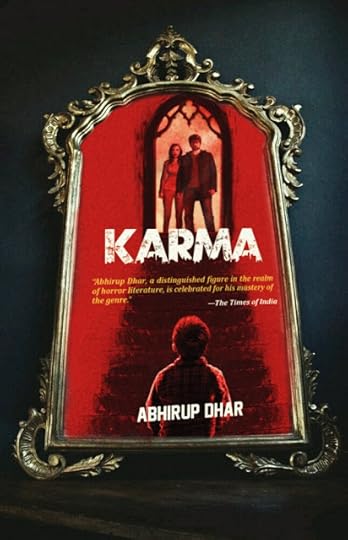 Karma by Abhirup Dhar
Karma by Abhirup DharAuthor: Abhirup Dhar
ISBN: 978-8119750528
Genre: Horror Fiction
Length: 136 Pages
Publication Date: 27th August 2024Publisher: Om Books International
Order your copy right now: https://amzn.to/3VRKclz
About the Author:
Abhirup Dhar is a Kolkata-born bestselling author. His books include Once Again... With Love! and Stories Are Magical after which he delved into horror with Hold That Breath (1 and 2), Hauntings and The Belvoirbrooke Haunting which were very well-received, with Hauntings being an Amazon bestseller for months from the very first day of its release. A name to be reckoned with in the genre of horror writing in India, one of his most famous projects, Ghost Hunter: Gaurav Tiwari, was phenomenally received, topped the Amazon charts, and has been acquired for a screen adaptation. Abhirup is also a screenwriter, working with esteemed people from the Indian film industry.
 Abhirup Dhar
Abhirup DharInstagram: @abhirup.dhar0906
Disclaimer: This review is only intended to initiate discussions. The opinions and views presented in this article are my own and do not reflect anything about the book's author.
The allure of a haunting often lies in the spaces where the past whispers into the present, its echoes ricocheting through shadowy corridors and fractured sense of reality. In this meticulously crafted novella by Abhirup Dhar, these whispers are deafening, reverberating across decades to weave an unsettling tale. Set against the brooding, mist-draped mountains of Darjeeling, the narrative alternates between 1985 and 2016, inviting readers into a labyrinthine structure that is both mesmerizing and, at times, maddening.
The story begins in 1985, with Anuradha and Arnab relocating to an isolated, atmospheric house, a place intended to serve as a retreat from Kolkata’s frenetic pace. Their six-year-old son, Ricky, becomes the unwitting harbinger of the inexplicable as the family is drawn into an escalating vortex of paranormal occurrences. Fast-forward to 2016, when Karma, a professor of parapsychology, and Sakshi take residence in the same house. As the timelines entwine and fragment, the house itself emerges as a malevolent character, its secrets spilling forth with each revelation.
The narrative excels in its use of non-linear storytelling, particularly in the 2016 segments, which oscillate between Karma and Sakshi’s harrowing present and the origins of their relationship. This disjointed approach amplifies the suspense, forcing the reader to piece together a puzzle whose final image is as haunting as it is tragic. The interplay between the two eras is skillfully orchestrated, with fleeting details—an eerie piano chord, a ghostly voice—creating moments of recognition that further excite you.
Yet, the novella is not without its shortcomings. The relationship between Karma and Sakshi strains credulity; their whirlwind romance, forged over a chance encounter and a few eerie jaunts in the mountains, lacks the depth necessary to make Sakshi’s decisions seem plausible.
Thematically, the book delves into profound questions about the fragility of modern relationships. Sakshi and Karma’s interactions expose the fault lines of distrust, impulsivity, and emotional withdrawal, contrasting sharply with the more grounded (if equally tragic) dynamic of Anuradha and Arnab. This subtle critique of human connections in an age of impermanence lends the book a layer of universality, even as its horrors are firmly rooted in the supernatural.
The horror elements themselves are impeccably rendered, eschewing cheap thrills for an atmosphere steeped in dread. The house becomes a tableau of spectral phenomena: a mirror that serves as a portal to another realm, the hollow resonance of a piano played by unseen hands, and the chilling lore of Darjeeling’s haunted past. The author’s restraint is commendable, unveiling just enough to keep the reader teetering on the edge of comprehension without ever slipping into exposition.
Despite these flaws, the book triumphs in its ability to meld two distinct timelines into a cohesive whole, its structural elegance matched only by the vividness of its fear factor. The climactic unravelling is both devastating and cathartic, offering readers a satisfying resolution to the intricate web of events. This is a book that demands patience, rewarding readers who can endure its slower moments with a payoff that lingers long after the final page.
Happy Reading!
Are you on Instagram and Goodreads? Let's connect!
.gr_grid_container { /* customize grid container div here. eg: width: 500px; */ } .gr_grid_book_container { /* customize book cover container div here */ float: left; width: 98px; height: 160px; padding: 0px 0px; overflow: hidden; }




















Dhiraj Sindhi's favorite books »
Share book reviews and ratings with Dhiraj, and even join a book club on Goodreads.
=========================
Follow me on Instagram, Facebook, Twitter, and Pinterest. Don't forget to subscribe for more content. Thank you so much for reading!
Will see you in the next post. Till then buh-bye. Take Care. Peace. ☮
October 1, 2024
Sakina's Kiss by Vivek Shanbhag | Translated from the Kannada by Srinath Perur
Sakina's Kiss by Vivek Shanbhag Translated from the Kannada by Srinath Perur Book Review by Dhiraj Sindhi
 Sakina's Kiss by Vivek Shanbhag | Translated from the Kannada by Srinath Perur
Sakina's Kiss by Vivek Shanbhag | Translated from the Kannada by Srinath PerurAuthor: Vivek Shanbhag
Translator: Srinath Perur
ISBN: 978-0670098835
Genre: Literary Fiction
Length: 194 Pages
Publication Date: 9th October 2023Publisher: VINTAGE (An Imprint of Penguin Random House India)
Order your copy right now: https://amzn.to/3ZIzOzl
About the Author: Vivek Shanbhag (Author) VIVEK SHANBHAG is a Kannada author, editor and playwright. He founded the pioneering literary journal Desha Kaala, editing it for seven years. His works include the widely translated Ghachar Ghochar. Although his stories are regularly translated and anthologised, Sakina’s Kiss is only his second complete work to be translated into the English. He is a Visiting Professor of Creative Writing at the Ashoka University. He is an engineer by training and lives in Bangalore.
 Vivek Shanbhag
Vivek ShanbhagX: @vivekshanbhag0
About the Translator: Srinath Perur (Translator) SRINATH PERUR writes about science, travel and books among other things and translates from Kannada to English. He is the author of the travelogue If It's Monday It Must Be Madurai and the translator of This Life at Play and Ghachar Ghochar.
 Srinath Perur (Courtesy: Hindustan Times)
Srinath Perur (Courtesy: Hindustan Times)Disclaimer: This review is only intended to initiate discussions. The opinions and views presented in this article are my own and do not reflect anything about the book's author.
Vivek Shanbhag’s Sakina’s Kiss—translated with graceful precision by Srinath Perur—masterfully sketches a portrait of Venky, a man caught between the comforts of his patriarchal conditioning and his ideological certainties falling flat slowly. Through Venky, Shanbhag explores a multitude of societal themes, from patriarchal family dynamics to the inescapable influence of politics, all without the novel feeling heavy-handed.
Almost instantly, we are introduced to Venky’s characteristic indecision and passive approach to life. A man steeped in self-improvement books and TV news debates, Venky’s thoughts on women, relationships, and family are shaped more by societal influence than by personal understanding. His relationship with his wife, Viji, has become one defined by unspoken tensions. The irony of Venky’s character is central to the novel. He is, in many ways, a man bound by his own contradictory beliefs.
But what stands out most in Sakina’s Kiss is the way Shanbhag explores larger socio-political undercurrents through the lens of Venky’s middle-class existence. Shanbhag weaves in topics like rural land grabs, farmer peasantry, and the rise of Naxalism, seen through the figure of Venky’s uncle, Ramana, who becomes radicalized. Venky, on the other hand, is caught in a tug-of-war between the pressures of fatherhood and the weight of his own insignificance in a rapidly modernizing world.
His thoughts about his daughter’s budding independence and rebellious streak are shaped more by his fears than any genuine understanding of Rekha’s needs. At its core, Sakina’s Kiss delves into Venky’s journey of confronting—and often suppressing—his own vulnerability. His life, shaped by the male-dominated social structures of his upbringing, leaves him awkwardly negotiating his encounters with people with higher or equal authority and the weight of his role as a father. In the novel’s climax, Venky is forced to reckon with this fragility when a break-in at their home occurs—a metaphorical and literal invasion that throws his carefully managed life into disarray.
The brilliance of Shanbhag’s storytelling lies in its restraint. There are no grand resolutions, only the slow unravelling of Venky’s beliefs and the deeply personal yet highly political choices his family faces. This open-endedness mirrors the reality of living in a world where politics, personal relationships, and identity are constantly in flux.
Sakina’s Kiss offers no easy answers, but it poses necessary questions about modern India’s grappling with its past and future. Shanbhag’s ability to tackle multiple themes—from rural struggles and urban anxieties to generational conflicts—without losing the novel’s intimate tone is what makes it a deeply compelling, nuanced read.
Happy Reading!
Are you on Instagram and Goodreads? Let's connect!
.gr_grid_container { /* customize grid container div here. eg: width: 500px; */ } .gr_grid_book_container { /* customize book cover container div here */ float: left; width: 98px; height: 160px; padding: 0px 0px; overflow: hidden; }




















Dhiraj Sindhi's favorite books »
Share book reviews and ratings with Dhiraj, and even join a book club on Goodreads.
=========================
Follow me on Instagram, Facebook, Twitter, and Pinterest. Don't forget to subscribe for more content. Thank you so much for reading!
Will see you in the next post. Till then buh-bye. Take Care. Peace. ☮
I Wish You All the Best by Mason Deaver | Book Review by Dhiraj Sindhi
I Wish You All the Best by Mason DeaverBook Review by Dhiraj Sindhi
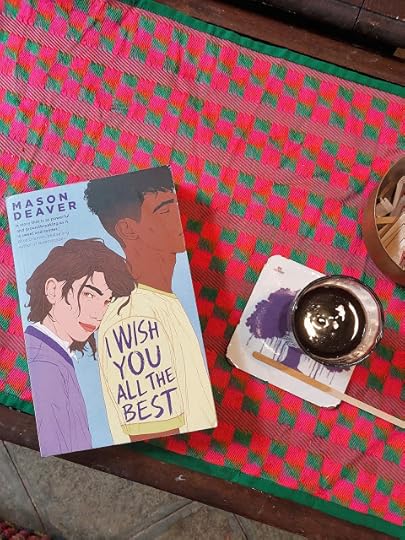 I Wish You All the Best by Mason Deaver
I Wish You All the Best by Mason DeaverAuthors: Mason Deaver
ISBN: 978-1035026227
Genre: Contemporary Fiction
Length: 336 Pages
Publication Date: 13th April 2023Publisher: Macmillan Children's Books
Cover Illustration: Sarah Maxwell
Order your copy right now: https://amzn.to/4drfrKj
About the Author: Born and raised in a small town in North Carolina, Mason Deaver is an award-nominated, bestselling author and designer living in Charlotte. Their debut novel, I Wish You All the Best, was named a Junior Library Guild Selection and an NPR Concierge Book. Besides writing, they're an active fan of horror movies and video games. You can find them online at masondeaverwrites.com
 Mason Deaver
Mason DeaverInstagram: @mason_deaver
Disclaimer: This review is only intended to initiate discussions. The opinions and views presented in this article are my own and do not reflect anything about the book's author.
I started reading this book in a café, and I couldn't put it down. The first few chapters were intense, narrating some of the most fearful yet liberating moments in the lives of many queer people. Benjamin De Backer comes out as nonbinary and is immediately kicked out of their home. Their estranged sister, Hannah, who hadn't spoken to the family for a decade after her own fallout with their parents, steps in to rescue them. She offers Ben a refuge at her home, where she lives with her husband, a teacher. She gets Ben into therapy and enrols them in her husband’s school mid-term.
From there, the book smoothly takes you through the various aspects of Ben’s new life in Raleigh. The inner struggle of not conforming to the gender binary, attending therapy, battling anxiety and depression—all while managing school and making new friends—feels very real. Making new friends, in fact, becomes a lifeline for Ben. A sweet, almost too-cute love story begins to blossom. The book features some vivid, powerful scenes that are unforgettable, and surprisingly, none of them are romantic. One of my favourite moments is a conversation between Ben and Hannah, where she convinces Ben to get out of bed and face the day. That scene, for me, held more power than any therapy session—pure wisdom. Sure, there are a few cliché tropes, like attending a party and online confidant, reminiscent of the dynamic between Victor and Simon in the Simonverse.
I went into this book expecting to learn something fresh about the nonbinary experience, perhaps something I hadn’t encountered before. However, early on, I realized it wasn't going to offer anything radically unique within the well-trodden American high school narrative. The family conflict and romance make for a strong premise, but the writing feels surface-level, often coming across as a customized version of an all-too-familiar setting with new accessories.
That said, I still enjoyed reading it! I think there’s a distinction between a truly great book and one you simply like reading. This one definitely gave me those butterfly-in-the-stomach moments. It also made me reflect on why some people, especially in Eastern cultures—including Bollywood icons—tend to resist labels when it comes to sexuality and gender identity. This book is an example of how labels, at times, can reduce the nonbinary experience to just pronouns. However, it still validates the complex emotions and struggles that come with gender dysphoria, while delivering much-needed optimism. It's a cosy, safe corner for those searching for comfort and reassurance.
Happy Reading!
Are you on Instagram and Goodreads? Let's connect!
.gr_grid_container { /* customize grid container div here. eg: width: 500px; */ } .gr_grid_book_container { /* customize book cover container div here */ float: left; width: 98px; height: 160px; padding: 0px 0px; overflow: hidden; }




















Dhiraj Sindhi's favorite books »
Share book reviews and ratings with Dhiraj, and even join a book club on Goodreads.
=========================
Follow me on Instagram, Facebook, Twitter, and Pinterest. Don't forget to subscribe for more content. Thank you so much for reading!
Will see you in the next post. Till then buh-bye. Take Care. Peace. ☮
September 11, 2024
The Parents I Met by Mansi Zaveri | Book Review by Dhiraj Sindhi
The Parents I Met by Mansi ZaveriBook Review by Dhiraj Sindhi
 The Parents I Met by Mansi Zaveri
The Parents I Met by Mansi ZaveriAuthors: Mansi Zaveri
ISBN: 978-0143459743
Genre: Non-Fiction | Parenting
Length: 296 Pages
Publication Date: 27th November 2023Publisher: Ebury Press by Penguin Random House India
Cover Designer: Sparsh Raj Singh | LinkedIn: @sparsh-raj-singh-42ab647
Order your copy right now: https://amzn.to/3AYDqmN
About the Author: Mansi Zaveri is the founder and CEO of India’s most trusted discovery platform for parenting and childcare, Kidsstoppress.com, which boasts a digital reach of 20 million people per month. She was also featured in Exchange4Media's Content 40 Under 40 list in 2020. Based in Mumbai, this mom of two took no time in combining her passion for the digital medium and her parenting journey to become an entrepreneur, leaving behind her corporate life to empower parents to make informed choices.
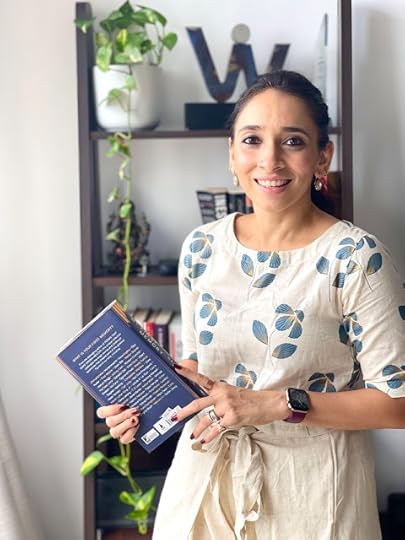 Mansi Zaveri
Mansi ZaveriInstagram: @mansi.zaveri
Disclaimer: This review is only intended to initiate discussions. The opinions and views presented in this article are my own and do not reflect anything about the book's author.
Mansi Zaveri’s The Parents I Met takes readers through the personal stories and parenting strategies behind some of India’s successful and influential individuals. Zaveri’s access to this cross-section of high achievers offers valuable insights into the emotional and psychological principles that guide effective parenting, providing readers with a wealth of anecdotes and lessons that are undeniably helpful for many parents looking to better understand the role they play in their children’s success. However, while the book has merit, it falls short in several areas, particularly when it comes to addressing broader cultural, social, familial, and class-related complexities.
At its core, the book excels in offering practical wisdom gleaned from parents who emphasize nurturing curiosity, allowing children to pursue their passions, and fostering a sense of independence. The anecdotes are compelling in their specificity, shedding light on how parents can encourage children to take calculated risks and navigate non-traditional paths or even traditional paths set by the parents themselves. However, despite these useful lessons, the book often leans into an idealized version of parenting, one that portrays family life as relatively harmonious and conflict-free. Parents in Zaveri’s interviews seem to always listen, support and eventually agree with their children’s unconventional choices. This presents an overly sanitized portrayal of the parent-child dynamic, one that lacks the messiness, friction, and negotiation that typically characterizes ordinary family relationships.
Zaveri’s line of questioning often results in repetitive and shallow insights. Time and again, the same themes emerge: give your children freedom within boundaries, let them make their own decisions, and allow them to follow their passions. While these are certainly important points, they are hardly groundbreaking. Beyond material wealth, the book also misses an opportunity to explore and acknowledge the social capital that is instrumental in these success stories. The parents of these successful individuals may not always be privileged, but they often have access to a broader network of intellectual or cultural resources, whether through education, social standing, or simply an enlightened approach to parenting that might be difficult to replicate in more constrained circumstances.
While it's undeniable that parenting and upbringing shape foundational aspects of a child's development, attributing success to parental influence oversimplifies a far more complex equation. The achievements of these individuals may reflect a confluence of personal resilience, broader societal factors, and opportunities beyond the scope of even the most conscientious parenting. Many individuals achieve greatness despite difficult or broken family dynamics. There are countless stories of people who have rebelled against parental expectations, overcome family trauma, or thrived in environments where emotional support was absent. These individuals often develop resilience, independence, and determination precisely because of the challenges they face, not in spite of them. The lack of such diversity suggests a somewhat narrow definition of what constitutes true accomplishment. It overlooks the myriad ways in which success can manifest and the varied circumstances from which people rise to prominence.
The concept of Mansi Zaveri’s book, while valuable in its exploration of parenting strategies behind successful individuals, is fundamentally flawed in its scope and representation. It excludes the realities of more diverse family backgrounds, particularly those from underprivileged, conflict-ridden, or non-traditional households. Expecting parents—especially parents outside the scope of these examples—to glean actionable insights from these idealized examples would be to assume that they reflect the full spectrum of parenting experiences.
Mansi Zaveri, the dynamic founder of Kidsstoppress, is undoubtedly a force to be reckoned with in the digital parenting space. Her keen eye for trends and deep understanding of parental needs have made her platform a go-to resource for many Indian parents. Yet, while her book deeply resonates with a specific audience, the broader applicability of it sometimes feels limited, leaving certain parenting experiences untapped.
Happy Reading!
Are you on Instagram and Goodreads? Let's connect!
.gr_grid_container { /* customize grid container div here. eg: width: 500px; */ } .gr_grid_book_container { /* customize book cover container div here */ float: left; width: 98px; height: 160px; padding: 0px 0px; overflow: hidden; }




















Dhiraj Sindhi's favorite books »
Share book reviews and ratings with Dhiraj, and even join a book club on Goodreads.
=========================
Follow me on Instagram, Facebook, Twitter, and Pinterest. Don't forget to subscribe for more content. Thank you so much for reading!
Will see you in the next post. Till then buh-bye. Take Care. Peace. ☮
August 23, 2024
Like Being Alive Twice by Dharini Bhaskar | Book Review by Dhiraj Sindhi
Like Being Alive Twice by Dharini BhaskarBook Review by Dhiraj Sindhi
 Like Being Alive Twice by Dharini Bhaskar
Like Being Alive Twice by Dharini BhaskarAuthors: Dharini Bhaskar
ISBN: 978-0143466765
Genre: Dystopian Fiction
Length: 330 Pages
Publication Date: 29th March 2024Publisher: Penguin Viking
Cover Designer: Ahlawat Gunjan | Instagram: @ahlawat.gunjan
Order your copy right now: https://amzn.to/3ACB5NY
About the Author: Born in Bombay, Dharini has at various points also called the UK, Greece, Delhi and Bangalore home.Her debut novel These, Our Bodies Possessed by Light (Hachette India) was shortlisted for the 2020 JCB Prize for Literature, Tata Literature Live! (First Book: Fiction), and the Valley of Words book awards. She has been published in the anthology Day’s End Stories; is a columnist for The Free Press Journal; and has contributed to Hindu BLink, Arre, Firstpost, Mint Lounge, Vogue, among other publications.Dharini has spent over a decade in publishing, including as editorial director of Simon and Schuster India. When she’s not writing, she enjoys reading, painting, backpacking, and taking long bike rides with her little boy.
 Dharini Bhaskar
Dharini BhaskarInstagram: @dharinibhaskar
Disclaimer: This review is only intended to initiate discussions. The opinions and views presented in this article are my own and do not reflect anything about the book's author.
In Dharini Bhaskar's mesmerizing novel Like Being Alive Twice, the narrative unfolds with the delicate intricacy of a spider's web, catching the reader in its threads of parallel realities and choices made or missed. The story is anchored by Poppy (Priyamvada), a woman poised on the cusp of two divergent paths, each represented by a door—one yellow, one blue. Bhaskar's deft hand guides us through 15 chapters that alternately explore seven years as they were and as they could have been, leading us to a hauntingly inevitable conclusion: all doors, no matter how different, ultimately lead to the same place.
In the world of the yellow door, Poppy chooses Yuvi, a decision driven not by love but by a pragmatic retreat from the intensifying political climate. In contrast, the blue door offers her a life with Tariq, the man she truly loves, where they live the harsh realities of the insidious nature of authoritarian regimes that tally human worth with a chilling points system. Bhaskar's portrayal of this dystopian landscape is disturbingly familiar and eerily plausible, with its gated communities, strict social hierarchy, surveillance, smog-choked Bastis, and the looming threat of losing everything for stepping outside prescribed societal norms.
What sets Like Being Alive Twice apart is its exploration of alternate realities and the emotional undercurrents that run through both narratives. Bhaskar's masterful storytelling weaves together these parallel worlds, revealing the subtle connections and surprising coincidences that bind them, compelling the reader to flip back and forth, piecing together the connections between art, politics, and the personal lives of her characters. The narrative is richly textured with the recurring motifs; touchstones—books, paintings, anklet, sculpture, movies, and songs—serve as anchors, grounding the characters in their respective realities while highlighting the stark contrasts between them.
The novel's exploration of politics is unflinching, and the individual's relationship to power is particularly poignant. The supreme leader's rule, with its draconian points system, is a thinly veiled critique of majoritarianism, authoritarianism, and societal pressures, where freedoms are increasingly curtailed, and individual worth is quantified. Each tally determines the citizens' place in one of the gated enclaves—Palash, Kadamba, Champa—and their rank in a rigid hierarchy. Points are meticulously tracked: marry outside your religion, delay marriage, or fail to conceive within five years, and your score drops, risking exile from your Bagh. Even the points of parents dictate their children's futures, with any misstep—a forbidden affair, for instance—leading to a public inquiry and potential banishment. The unlucky subjects are relegated to the Bastis or, worse, the Door Mohalla. The Baghs, with their floral names, mask the thorny reality of life under constant scrutiny, where love, freedom, and ethics are commodities traded for a higher score.
It highlights the importance of individual agency and the power of love that transcends adversity. Yet, Bhaskar never allows the political to overshadow the personal. Poppy's relationship with her mother, for instance, remains a constant in both worlds, offering a moving exploration of how love and resentment can coexist, shaped but never fully determined by external circumstances.
Bhaskar's narrative technique is striking in its use of parallel events to underscore the differences and similarities between the two worlds. These moments of interconnectedness are not just clever literary devices but profound meditations on the nature of choice and fate.
Bhaskar brings both worlds crashing together in a heartbreaking conclusion. The novel's ending, where all paths converge in tragedy, is both devastating and cathartic; it's a sobering reminder of the inescapable consequences of living in a world divided by faith, power, and fear. It is a potent exploration of how, despite our choices, we are ultimately shaped by forces beyond our control.
Like Being Alive Twice is a triumph of narrative craft, a novel that demands to be read and reread, each time revealing new layers of meaning. Bhaskar's prose is lyrical yet precise, her characters vividly drawn, and her narrative structure innovative without being gimmicky. She has given us a story that is as much about the worlds we inhabit as it is about the ones we imagine—a reminder that, no matter which doors we choose, we are always, in some way, the same.
"You can tug at a story this way or that. Close one door and walk through another. And here's where you'll find yourself."
Happy Reading!
Are you on Instagram and Goodreads? Let's connect!
.gr_grid_container { /* customize grid container div here. eg: width: 500px; */ } .gr_grid_book_container { /* customize book cover container div here */ float: left; width: 98px; height: 160px; padding: 0px 0px; overflow: hidden; }




















Dhiraj Sindhi's favorite books »
Share book reviews and ratings with Dhiraj, and even join a book club on Goodreads.
=========================
Follow me on Instagram, Facebook, Twitter, and Pinterest. Don't forget to subscribe for more content. Thank you so much for reading!
Will see you in the next post. Till then buh-bye. Take Care. Peace. ☮
May 30, 2024
People on Our Roof by Shefali Tripathi Mehta | A Family Caregiver's Journey
"Moss-Green Judgy-Eyed People on Their Roof Catalyze a Daughter and Sister’s Caregiving Journey Fraught with Absent Father, Amatory Turbulence, and a Quest for Catharsis"People on Our Roof by Shefali Tripathi MehtaBook Review by Dhiraj Sindhi
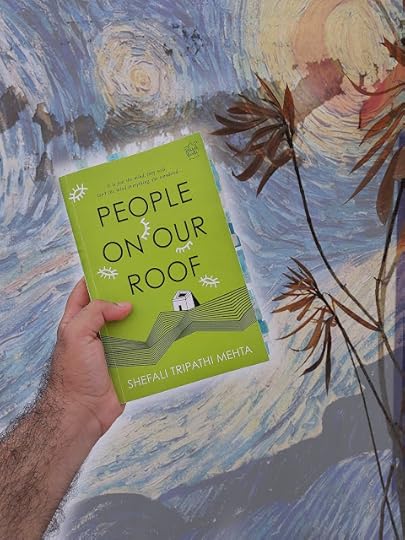 People on Our Roof by Shefali Tripathi Mehta
People on Our Roof by Shefali Tripathi MehtaAuthors: Shefali Tripathi Mehta
ISBN: 978-9389136708
Genre: Contemporary Fiction
Length: 228 Pages
Publication Date: 14th December2020Publisher: Niyogi Books India
Cover Designer: Misha Oberoi | Instagram: @misha.oberoi
Order your copy right now: https://amzn.to/3yJWSm8
About the Author: Shefali Tripathi Mehta’s most recent book is Ek Koshish: The Story of Arushi (2019). This is her fifth book and the second work of fiction after Stuck Like Lint (2017). She has published short stories and poems in anthologies and online. She writes on disability awareness, social issues, travel and parenting. For close to ten years, Shefali wrote the cover story for the Sunday supplement of the Deccan Herald. She lives in Bangalore and works at the Azim Premji University. Shefali volunteers with the disability organization, Arushi, and curates Gond art to support tribal artists.
 Shefali Tripathi Mehta
Shefali Tripathi MehtaInstagram: @shefalitripathimehta
Disclaimer: This review is only intended to initiate discussions. The opinions and views presented in this article are my own and do not reflect anything about the book's author.
In 1.7 billion strong India, 197.3 million people, or nearly 15% of the population, were battling mental disorders in 2017. In a country where nearly 1 in 7 people struggle unseen, People on Our Roof sheds light on the realities of living with and caring for those affected. Since numbers can't capture the human cost of mental disorders, this novel offers a poignant look at the emotional toll.
We've all encountered those in our communities grappling with mental illness, who wander the streets and markets of our neighbourhoods, perhaps engaging in seemingly nonsensical behaviour in a desperate plea for recognition or brandishing a stick, lost in solitary conversations. These quite conspicuous figures become invisible when it comes to understanding their psychiatric disability, their needs, and providing care. The stigma and lack of awareness render these realistic experiences as surreal. Still, this book validates these experiences by reflecting on the real world where knowing people with mental disorders is not uncommon.
People on Our Roof addresses this issue with refreshing candour. The protagonist's once-prosperous Delhi-based family, blessed with well-heeled privilege, circumvents the conventional "faith healing, crystal healing, exorcism" circuit by accessing a qualified medical expert. This subtle nod underscores the importance of modern psychiatric treatment, coupled with social support and compassionate care, as the dignified path toward healing.
However, family caregiving can be emotionally exhausting, and frustrating, and at times, it can strip one of identity and strain relationships, even beyond the family circle. Shefali Tripathi Mehta offers a refreshingly optimistic portrayal, grounded in realism, that avoids romanticizing the situation. She expertly straddles the fine line between depicting the challenges of caregiving and showcasing the unexpected pockets of joy within the quotidian chaos and the profound strength discovered within the caregiver.
There is the fear of the unknown, and greater still is the fear of the unknown within the minds of loved ones, which can weaken you even in the face of strangers. Yet, once you find the courage to overcome this fear and accept it for what it is, you conquer the world. This is the hope the book delivers, concluding with a delightful and uplifting ending.
Despite Naina’s struggles to make peace with her personal history, her mother’s psychotic episodes, the family's ostracism under the whispers of ‘pagalkhana,’ harrowing nightmares, the plight of independent women taking tough life decisions for themselves under the watchful, often disapproving eyes of society, and society's pitiless math deeming Naina fit only for a spouse branded by madness, People on Our Roof is enveloped in the warm embrace of the late 1990s. The narrative delights in the little things—crossword puzzles, childhood anecdotes, the Madhukamini bush, and chats over chai, all rendered in a soothing writing style imbued with penetrating empathy. A few male characters with sunny dispositions provide a safe haven, adding another vibrant thread to the fabric of this powerful tale.
Happy Reading!
Are you on Instagram and Goodreads? Let's connect!
.gr_grid_container { /* customize grid container div here. eg: width: 500px; */ } .gr_grid_book_container { /* customize book cover container div here */ float: left; width: 98px; height: 160px; padding: 0px 0px; overflow: hidden; }




















Dhiraj Sindhi's favorite books »
Share book reviews and ratings with Dhiraj, and even join a book club on Goodreads.
=========================
Follow me on Instagram, Facebook, Twitter, and Pinterest. Don't forget to subscribe for more content. Thank you so much for reading!
Will see you in the next post. Till then buh-bye. Take Care. Peace. ☮
April 6, 2024
Glitz, Gossip, and Greed: Ong Chin Huat's Harmony Heights Exposes the Underbelly of Opulence
"Glitz, Gossip, and Greed: Ong Chin Huat's Harmony Heights Exposes the Underbelly of Opulence"Harmony Heights by Ong Chin Huat Book Review by Dhiraj Sindhi
 Harmony Heights by Ong Chin Huat
Harmony Heights by Ong Chin HuatAuthors: Ong Chin Huat
ISBN: 978-9815144512
Genre: Contemporary Fiction, Dramedy
Length: 288 Pages
Publication Date: February 2024Publisher: Penguin Random House SEA
Cover Designer: Chinmayee Samant | Website: chinmayeesamant.com
Order your copy right now: https://amzn.to/3PRgeva
About the Writer: After graduating from the London School of Economics with a law degree and later called to the Bar in both the United Kingdom and Malaysia, Ong Chin Huat studied History of Art at the British Institute of Florence in Italy. Deciding to pursue a career in journalism, he became the first Chinese person to work at the Hong Kong Tatler as the Social Editor. After a stint as a columnist at the South China Morning Post, he started his own PR Consultancy specialising in fashion and luxury goods. He has been a judge for the Miss Asia Pageant in Hong Kong, Miss Charm de Chine in Shanghai and Mrs.International Global Grand Final in Kuala Lumpur. Currently, he is a freelance writer, fashion stylist and TV Host and has contributed to The Star, Life Inspired, Luxurious Magazine, Harper’s Bazaar, Design Anthology, Elle and Conde Nast Traveller among others. He hosted a TV Show called ‘Hong Kong High Life’ on ATV Hong Kong as well as a talk show named ‘Driven’ on TheStarTV.com. Voted as one of Hong Kong’s Best Dressed Personalities by the Hong Kong Fashion Designer’s Association, he has met and interviewed everyone from movie stars and business tycoons to politicians and world-class athletes.
 Ong Chin Huat (Source: Tatler Asia)
Ong Chin Huat (Source: Tatler Asia)Instagram: @chinhuat_ong
Disclaimer: This review is only intended to initiate discussions. The opinions and views presented in this article are my own and do not reflect anything about the book's author.
Ong Chin Huat's Harmony Heights takes us on a whirlwind tour of a Malaysian condominium complex. The setting is idyllic – a low-density condo retreat on the outskirts of KL. But beneath the surface of manicured lawns, designer facades, wealth, respectability lurk dysfunctions, deceit, mental health struggles, and a hunger for power.
The novel lays bare the hypocrisy of a society that prides itself on status while rotting from the inside out, where acts of desperation and greed could be seen as personal failings and systemic issues that perpetuate the cycle of disparity.
The strength of Chin Huat's novel lies in its characters. They're a fascinating bunch, each harbouring secrets that could shatter the illusion of their perfect lives. We've got a cast that's more crowded than a Black Friday sale. We have typical high-society types with closets so deep that you could lose a pair of Jimmy Choos in there and not find them until next season. Here, gossip flows faster than teh tarik at a mamak stall. But then we also get a glimpse of the struggles of the domestic workers and the immigrants trying to make ends meet. And the secrets? Oh, they're juicier than a ripe mango on a hot day.
Chin Huat throws us into this melting pot of cultures, nationalities, and social classes. There's Jan and Erika, a lesbian couple with their adopted Bangladeshi daughter, and Azizah, a former singer, alongside the wannabe aristocrat Padma and her equally troubled daughter Shivana. Widya, the Indonesian maid, harbours a secret romance with the groundskeeper, Iqbal, who lives with Asperger's. Let's not forget Dr. Desmond, a controlling patriarch who paints a far cry from the image of a respectable doctor. And many more! All with a side of drama that could give any soap opera a run for its money.
From Azizah's battle with menopause and its psychological effects to Padma's ****mania and Shivana's ****mia, Chin Huat paints a vivid picture of individuals struggling to cope with their personal demons. (**** - Mental health issues not mentioned to avoid spoilers.)
The initial chapters meander slowly, like a monsoon breeze. We're bombarded with introductions, each character sketch accompanied by a peek into their past and present woes. Just when you think it can't get any wilder, the narrative explodes around the 100-page mark. Flaws unfurl, secrets spill, relationships combust, and the narrative transforms into a full-blown suspenseful noir.
Despite the meticulously crafted build-up, the resolution is both abrupt and unbelievable. The individual character arcs are conveniently left dangling to readers' imagination. "Harmony Heights" stumbles in its attempt at a grand finale. The climax feels rushed, failing to deliver a satisfying resolution to the multitude of brewing conflicts.
Instead of a grand, unifying climax, we get a series of individual denouements. The individual resolutions feel underwhelming. The ending is open-ended, not in a way that tantalizes but in a manner that feels incomplete. It's like devouring a seven-course meal only to find the main course missing.
Harmony Heights gets bogged down by its sprawling cast and melodramatic climax. The constant brand-dropping becomes a distraction. It's like the characters are walking advertisements, but it gets a bit eye-roll-inducing after a while.
There's also a nagging sense of missed opportunities. The overarching societal issues teased throughout the novel remain unexplored. Each resident is a potential protagonist, brimming with a backstory and struggles begging to be explored. Honestly, this feels like the first season of a killer show - this gossip rag of a novel deserves a second act! (I can't wait to see where Chin Huat takes things next.) Each book could delve into the lives of a specific character or group, tackling social issues and personal battles with greater nuance. Each book could culminate in a character arc that feels earned, delivering the closure that the sprawling narrative of the single novel lacks.
Despite its shortcomings, the novel has flashes of brilliance. The characters, especially Jan, Erika, Widya, and Iqbal, are endearing and complex. The book is a reflection of life's complexities, and while it may not offer all the answers, it certainly raises some thought-provoking questions. Through its characters, the book challenges readers to look beyond the surface and see the actual cost of fake elitism. It's a reminder that the most dangerous kind of poverty is the one that affects empathy, equality, and justice.
Harmony Heights is a juicy, fast-paced read. It's a peek into the lives of the privileged, the struggling, and everyone in between, reminding us that appearances can be deceiving. Harmony Heights will keep you turning the pages. It's a front-row seat to the greatest show of human nature in all its flawed glory. And trust me, you don't want to miss this spectacle.
Happy Reading!
Are you on Instagram and Goodreads? Let's connect!
.gr_grid_container { /* customize grid container div here. eg: width: 500px; */ } .gr_grid_book_container { /* customize book cover container div here */ float: left; width: 98px; height: 160px; padding: 0px 0px; overflow: hidden; }




















Dhiraj Sindhi's favorite books »
Share book reviews and ratings with Dhiraj, and even join a book club on Goodreads.
=========================
Follow me on Instagram, Facebook, Twitter, and Pinterest. Don't forget to subscribe for more content. Thank you so much for reading!
Will see you in the next post. Till then buh-bye. Take Care. Peace. ☮
March 17, 2024
Book Review: "Don't Shut Up: How to Talk So the World Listens" by Prakhar Gupta and Mudit Yadav
"Don't Shut Up: How to Talk So the World Listens by Prakhar Gupta and Mudit Yadav"Book Review by Dhiraj Sindhi
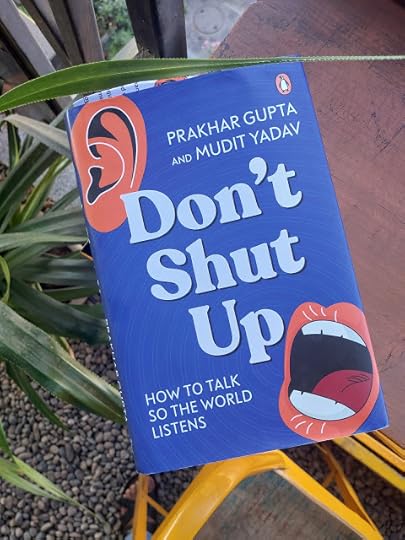 Don't Shut Up: How to Talk So the World Listens by Prakhar Gupta and Mudit Yadav
Don't Shut Up: How to Talk So the World Listens by Prakhar Gupta and Mudit YadavAuthors: Prakhar Gupta, Mudit Yadav
ISBN: 978-0670099788
Genre: Self-Help, Communication & Social Skills
Length: 280 Pages
Publication Date: 2nd February 2024Publisher: Penguin eBury Press
Cover Designer: Sparsh Raj Singh | LinkedIn: Sparsh Raj Singh
Order your copy right now: https://amzn.to/3vm8b2f
About the Writer: Prakhar Gupta is an entrepreneur, podcaster, content creator and keynote speaker. Equipped with a deep understanding of human behaviour, Prakhar creates content around psychology, philosophy, culture and life. His ideas have popularized him on the internet and within a few years, he has built a community of over half a million followers across YouTube, Instagram, Twitter and LinkedIn. Prakhar co-founded LearnWithPrakhar, India's first EdTech platform for super skills, in 2021. He holds a degree in economics and psychology from Columbia University, New York, and is a regular speaker at top institutes across India.
 Prakhar Gupta
Prakhar GuptaInstagram: @prakharkepravachan
About the Writer: Mudit Yadav is a keynote speaker and executive coach who has spoken to more than 4,50,000 people from over forty-eight countries and also at multiple TEDx events. He is also the co-author of Don't Shut Up: How to Talk So the World Listens. He works with celebrities, executives and entrepreneurs, enabling them to be more successful, develop greater presence, elevate their communication skills and lead a life of abundance. He has conducted sessions in six continents for various organizations, including AmEx, Workday, Google, Siemens, PwC, EY, Deloitte, Cisco, Caterpillar, Roche, IIMA and IIMC. He is also a chartered accountant, CFA charterholder and ex-strategy consultant.
 Mudit Yadav
Mudit YadavInstagram: @mudit_y
Disclaimer: This review is only intended to initiate discussions. The opinions and views presented in this article are my own and do not reflect anything about the book's author.
"Don't Shut Up" by Prakhar Gupta and Mudit Yadav promises to equip readers with the tools to navigate any conversation confidently and finesse, from icebreakers to boardroom showdowns, with plenty of waypoints in between (nailing that first date, delivering a compelling speech, creating a personal brand at work, or finally learning to say no).
Divided into two parts, the book tackles the social complexities of young adulthood (by Gupta) and the professional world (by Yadav).
The strength of this practical handbook lies in its structured approach. Each chapter is divided into digestible sections that cover various aspects of communication with precision. The authors adeptly blend theoretical frameworks with real-life examples, facts, and anecdotes, enhancing the reader's understanding and engagement.
The book's second half, authored by Mudit Yadav, shines with its clarity and systematic approach. Readers will find invaluable insights into effective communication in professional settings presented in a concise, cohesive, and engaging manner.
However, the charm of the "Grown-Up Zone" doesn't translate to Prakhar Gupta's "Studenthood to Adulthood." The frenetic energy of the first part, while undeniably enthusiastic, lacks organization and cohesive flow. Some chapters feel out of place and poorly executed.
Additionally, a couple of situations in the first part suffer from a glaring blind spot regarding inclusivity. Gupta's disclaimer that his advice is "for the heterosexual experience" (for a particular chapter) feels unnecessary, exclusionary, and potentially alienating. Perhaps the most egregious misstep is Gupta's advice on coming out to parents. While it might be intended as a joke, it trivializes the coming out experience, which can be nerve-wracking and emotional. The focus should have been on creating a safe and supportive space for communication. Such instances detract from the book's credibility and perpetuate harmful stereotypes and attitudes.
While Gupta's social advice occasionally stumbles, his section offers some effective toolkits for difficult conversations with parents, witty comebacks, conveying disagreement, building confidence, and apologizing.
So, should you "Don't Shut Up?" Despite its shortcomings, the answer is a qualified yes for those seeking a polished handbook on conquering professional interactions. Mudit Yadav's section is a gem, offering actionable tips for the aspiring power communicator. However, the unevenness of the first part and the occasional lapses in judgment make "Don't Shut Up" a book best dipped into with a discerning eye.
Happy Reading!
Are you on Instagram and Goodreads? Let's connect!
.gr_grid_container { /* customize grid container div here. eg: width: 500px; */ } .gr_grid_book_container { /* customize book cover container div here */ float: left; width: 98px; height: 160px; padding: 0px 0px; overflow: hidden; }




















Dhiraj Sindhi's favorite books »
Share book reviews and ratings with Dhiraj, and even join a book club on Goodreads.
=========================
Follow me on Instagram, Facebook, Twitter, and Pinterest. Don't forget to subscribe for more content. Thank you so much for reading!
Will see you in the next post. Till then buh-bye. Take Care. Peace. ☮
December 2, 2023
Chronicling Shame-Veiled Sensual Realities: 'Cockatoo's' Liberating Echo | Cockatoo by Yashraj Goswami
"Chronicling Shame-Veiled Sensual Realities: 'Cockatoo's' Liberating Echo"Cockatoo by Yashraj GoswamiBook Review by Dhiraj Sindhi
 Cockatoo by Yashraj Goswami
Cockatoo by Yashraj GoswamiAuthor: Yashraj Goswami
ISBN: 978-9389109955
Genre: Collection of Short Stories
Length: 216 Pages
Publication Date: 18th July 2023Publisher: Pan
Cover Illustration and Design: Devangana Dash | Website: https://www.devanganadash.com/
Order your copy right now: https://amzn.to/3Rrmc6Y
About the Author:
Yashraj Goswami is a writer, poet and teacher based in Delhi. His words have appeared in various publications, including the Indian Express, Huffington Post, Scroll.in, and DNA. His poems and short stories have been widely anthologized. His writing gently probes the varied shades and expressions of masculinity in modern India. Cockatoo is his first book.
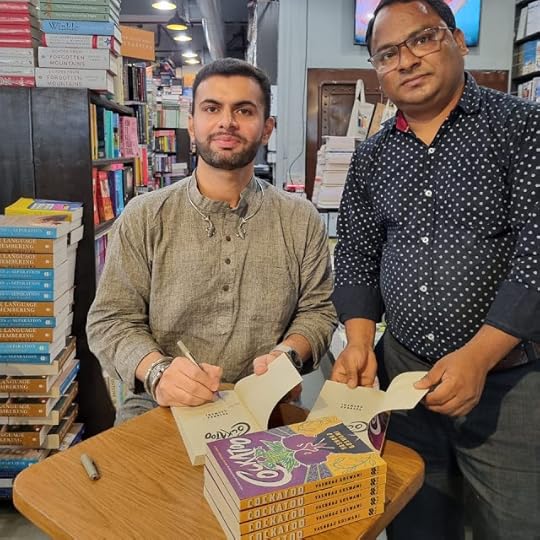 Yashraj Goswami (PC: Youth Ki Awaaz)
Yashraj Goswami (PC: Youth Ki Awaaz)Instagram: @mubble.fubbles
Twitter: @aviDSays
Disclaimer: This review is only intended for initiating discussions. The opinions and views presented in this article are my own and do not reflect anything about the book's author.
I finished reading this gem a few days ago, yet I found myself at a loss for words to convey my thoughts immediately after finishing it. I took time to let this paperback sink in. Cockatoo, seemingly a collection of short stories, goes beyond the concept of a novel. It features diverse characters and narratives, all set in ordinary Indian surroundings. It highlights the profound spectrum of emotions and experiences that characterize everyday life.
It's remarkable how authentically the author portrays these themes, given that our society tends to sweep anything unconventional under the rug. A significant part of society, including anxious and conservative Indian youth, remains closed to discussing or destigmatizing natural aspects of life, like desire, sex, sexuality, dating, non-binary gender identity, mental health, and the stigma surrounding infertility. While acknowledging that change is underway, I feel that the pace of this transformation is not ideal, and any halt in progress could regress us to where we began. Goswami also sheds light on critical issues like divorce, barriers to quality healthcare for trans people, domestic violence, and police brutality.
These subjects aren't superficially tackled; Goswami has crafted finely detailed stories with well-fleshed-out characters, intricately woven and nested structures, and brilliant storytelling from various perspectives, utilizing irony and other literary devices to engage with readers on an open canvas that says, "you may see it coming, but I'm going to surprise you anyway." I found myself laughing, shedding literal tears, and experiencing numerous jaw-dropping moments throughout my reading journey.
Despite the episodic and stand-alone nature of the stories, akin to the structure of Arabian Nights, the book culminates in a cohesive whole. Upon finishing the book, readers can piece together a completed puzzle—a comprehensive novel with a clear beginning, middle, and closure. And since this work of joining the dots is upon readers, or you can say because of its open-endedness, readers get a huge enough canvas to make the best out of their reading experience. You can't get enough of it.
Goswami, in this debut masterpiece, demonstrates exceptional storytelling skills and accomplishes a commendable feat in stirring the depths of the reader's mind with thought-provoking narratives. These stories deserve to be read and retold, for they carry significant impact and offer validation to the diverse and queer experiences they portray.
Happy Reading!
Are you on Instagram and Goodreads? Let's connect!
.gr_grid_container { /* customize grid container div here. eg: width: 500px; */ } .gr_grid_book_container { /* customize book cover container div here */ float: left; width: 98px; height: 160px; padding: 0px 0px; overflow: hidden; }




















Dhiraj Sindhi's favorite books »
Share book reviews and ratings with Dhiraj, and even join a book club on Goodreads.
=========================
Follow me on Instagram, Facebook, Twitter, and Pinterest. Don't forget to subscribe for more content. Thank you so much for reading!
Will see you in the next post. Till then buh-bye. Take Care. Peace. ☮



